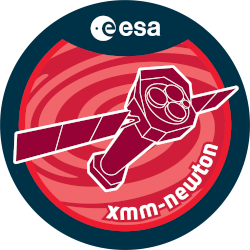

| Proposal ID | 069399 |
| Title | X-ray spectroscopy of the first z>7 QSO |
| Download Data Associated to the proposal | https://nxsa.esac.esa.int/nxsa-sl/servlet/data-action-aio?obsno=0693990101 |
| DOI | https://doi.org/10.5270/esa-sfc98w7 |
| Principal Investigator, PI | Dr Mathew Page |
| Abstract | We have recently discovered the most distant QSO, ULAS J1120+0641, at z=7.085,just 760 Myr after the big bang. As the first luminous, persistent source to bediscovered at z>7, ULAS J1120 is a unique probe of the intergalactic medium deepin the epoch of reionization, and already constrains the neutral fraction to bemore than 10% at z=7. Its black hole is estimated to be 2.0e9 Msun, and thesmall size of the ionized region in which it is embedded implies it has beenshining for less than 10^7 yrs. Thus it also provides important constraints onthe formation and evolution of massive black holes. We propose to obtain anX-ray spectrum with XMM-Newton to examine the physical conditions in this youngQSO, and to better determine its ionizing spectrum for reionization modelling. |
| Publications |
|
| Instrument | EMOS1, EMOS2, EPN, OM, RGS1, RGS2 |
| Temporal Coverage | 2012-05-23T10:49:06Z/2012-06-21T16:12:42Z |
| Version | 17.56_20190403_1200 |
| Mission Description | The European Space Agencys (ESA) X-ray Multi-Mirror Mission (XMM-Newton) was launched by an Ariane 504 on December 10th 1999. XMM-Newton is ESAs second cornerstone of the Horizon 2000 Science Programme. It carries 3 high throughput X-ray telescopes with an unprecedented effective area, and an optical monitor, the first flown on a X-ray observatory. The large collecting area and ability to make long uninterrupted exposures provide highly sensitive observations. Since Earths atmosphere blocks out all X-rays, only a telescope in space can detect and study celestial X-ray sources. The XMM-Newton mission is helping scientists to solve a number of cosmic mysteries, ranging from the enigmatic black holes to the origins of the Universe itself. Observing time on XMM-Newton is being made available to the scientific community, applying for observational periods on a competitive basis. |
| Creator Contact | https://www.cosmos.esa.int/web/xmm-newton/xmm-newton-helpdesk |
| Date Published | 2013-07-12T00:00:00Z |
| Last Update | 2025-08-04 |
| Keywords | "XMM", "persistent source", "ionized region", "reionization modelling", "XMM-Newton", "distant qso", "ionizing spectrum", "physical conditions", "intergalactic medium deep", "xmm newton", "0e9 msun", "massive black holes", "xray spectrum", "neutral fraction", "760 myr", "x ray spectroscopy", "embedded implies", "ulas j1120" |
| Publisher And Registrant | European Space Agency |
| Credit Guidelines | European Space Agency, Dr Mathew Page, 2013, 'X-ray spectroscopy of the first z>7 QSO', 17.56_20190403_1200, European Space Agency, https://doi.org/10.5270/esa-sfc98w7 |